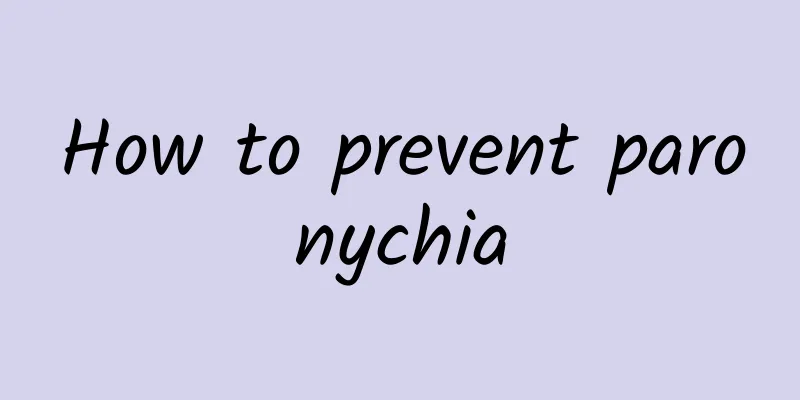How to prevent paronychia

|
Paronychia is a common suppurative infection of the hands and feet. It mainly affects adolescents, with the highest incidence among middle school students. It is mainly caused by trauma, squeezing when wearing shoes, improper nail trimming, hereditary ingrown nails, etc. Acute paronychia is manifested by local redness, swelling, heat, and pain. In severe cases, it presents as throbbing pain and local suppuration. If not treated in time, it is easy to develop into chronic paronychia and even form suppurative digit/toe inflammation. It seriously affects normal life, especially for adolescent patients, not only affecting their study and life, but also affecting their family members and even the entire family life, so prevention is very important. What is paronychia Paronychia refers to an infectious inflammation caused by pathogens invading the subcutaneous tissue through tiny damage in the nail groove tissue on both sides of the fingers (toes) and growing and multiplying due to various reasons. It is common in the tissues surrounding the fingers (toes). Clinical manifestations of paronychia According to the condition of paronychia wound, it is divided into Ⅰ-Ⅳ Stage I (redness and swelling): The nail structure is intact, the lateral nail folds are red and swollen, with keratinization and hyperplasia, and no exudate. The edge of the nail can be buried in the red and swollen folds, and there may be pain when squeezing the nail periphery; Stage II (inflammatory stage): The fingers/toes are more obviously deformed, the pain continues to worsen, there is serum-like or purulent secretion, sometimes with a foul odor, and there is a small amount of granulation. The lateral nail edge can be exposed by separating the periungual nail. Stage III (granulation stage): The fingers/toes are severely deformed, the nail plate plane is low, inflammatory granulomas are formed, and the lateral nail edge cannot be exposed by separating the periungual tissue, which is also called ingrown nail paronychia; Stage IV (chronic ingrown toenail paronychia formation stage): Due to repeated nail extraction, the nail area is significantly reduced, pigmentation occurs around the nails on both sides, chronic ingrown toenails are formed, or chelate-like toenails appear. Why do you get paronychia? 1. Improper manicure: Manicure is too deep or directly damages the soft tissue around the nail. The soft tissue beside the nail grows upward due to lack of nail coverage and is embedded in the soft tissue. Trauma causes the edge of the toenail to grow into the nail margin tissue and compress the soft tissue of the nail groove, resulting in secondary bacterial infection and causing paronychia. 2. Improper shoe wearing: Frequently wearing inappropriate shoes such as skinny shoes or pointed shoes will squeeze the toes, causing poor local blood circulation and even tissue damage and infection that may induce paronychia. 3. Sports injuries: Toe kicks, sprains, and trample injuries are common during sports, and these injuries are often ignored because there is no obvious local bleeding after the injury, leading to infection. 4. Not paying attention to foot hygiene: Teenagers have active sweat glands, their feet sweat so much that their shoes become damp, they wear non-breathable shoes, and they do not pay attention to foot hygiene, which can lead to local infection and cause paronychia. 5. Biting the hangnails: Roughly biting the hangnails will damage the skin tissue around the nails, and bacteria will invade the wound and cause nail infection, leading to paronychia. 6. Frequent manicures: Frequent manicures may cause the nails and surrounding skin tissue to become thinner and softer, which may easily lead to bacterial infection and cause paronychia. 7. Obesity: Being overweight causes excessive pressure on the feet, which causes the toenails to squeeze the nail grooves and cause inflammation of the periungual tissues. How to prevent paronychia 1. Trim your nails correctly: When trimming your nails, you should first trim them into a square shape, and then use a nail file to grind the edges of the nails on both sides into a slightly rounded shape. Avoid trimming your nails too deep, which may damage the nail bed and the soft tissue around the nails and cause infection. 2. Pay attention to hand and foot hygiene: wash your hands and feet frequently, change your shoes and socks frequently, especially after sweating during exercise. 3. Wear suitable shoes: Do not wear tight, thin, hard or non-breathable shoes to avoid squeezing your nails. 4. Maintain good hygiene habits: do not bite your nails, do not habitually pick your hands or feet. Do not pull out the "barbs" next to the nail groove, but carefully cut them off with scissors; avoid violent pulling and tearing of the skin around the nail, which may cause paronychia. 5. Avoid sports trauma: When exercising, avoid and reduce injuries such as stepping, falling, and kicking, which may cause damage to the nail groove or nail bed tissue, and secondary bacterial infection and cause paronychia. For patients whose wounds have just healed after nail removal, they should pay attention to reducing exercise. 6. Control your weight: reduce the pressure from your feet on your nail groove. 7. Don’t do manicures often: Don’t apply nail polish or wear artificial nails often, so as to avoid the nails losing their toughness, becoming thinner and softer, which may easily lead to bacterial infection and cause paronychia. Author: Qi Jiahong (The First Affiliated Hospital of Nanchang University) Reviewer: Zhang Chongni (The First Affiliated Hospital of Nanchang University, member of the Standing Committee of the Social Rehabilitation Committee of the Chinese Rehabilitation Medicine Association, executive director of the Jiangxi Rehabilitation Medicine Association, and chairman of the Social Rehabilitation Committee of the Jiangxi Rehabilitation Medicine Association) Editor: Zhu Xiaoqing (Xinhua Hospital Affiliated to Shanghai Jiaotong University School of Medicine) |
>>: Lung nodules ≠ lung cancer, stop scaring yourself!
Recommend
Cervical polyp front cauliflower shape
Women will have some gynecological inflammation t...
How long does it take to recover from cervical cyst surgery?
Cervical cyst is a very common cervical disease a...
Can I get pregnant two months after IUD removal?
In fact, many women who have given birth to their...
How can women get rid of acne without leaving marks?
We all agree that women are born to love beauty, ...
What do you need for a maternity bag?
Every family will be particularly cautious when w...
Protect the health of the elderly and beware of aspiration
As the aging society accelerates, the health prob...
Why is female urine red?
If a woman's urine is red, many people will f...
[Medical Q&A] How does myopia occur? How can it be prevented?
Planner: Chinese Medical Association Reviewer: Li...
Signs of dilated cervix during pregnancy
Many women have cervical dilation in the second t...
When is the best time to have an abortion during pregnancy?
In the same hospital and with the same gynecologi...
Ovulation induction therapy - "turning waste into treasure"?
When assisting pregnancy, reproductive doctors of...
Can I have abortion with medicine if I am more than two months pregnant?
If women want to terminate the pregnancy after an...
Things to note during menarche: Keep these points in mind
When a girl has her first menstruation, it will c...
Is it good for a woman to have a mole at the end of her right eye?
Having a mole at the end of the eye is a normal p...









